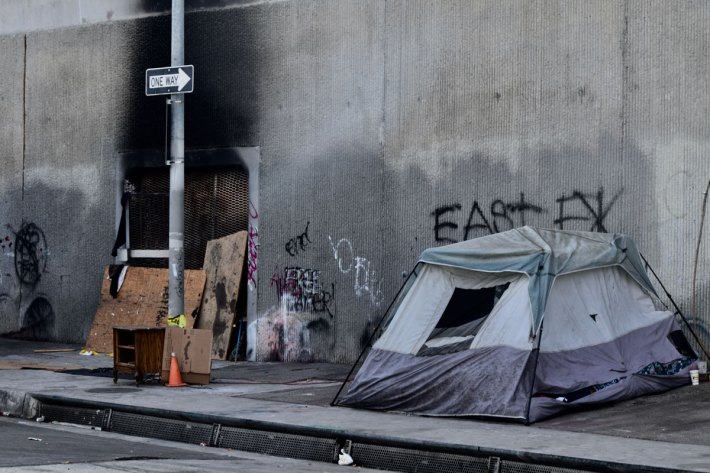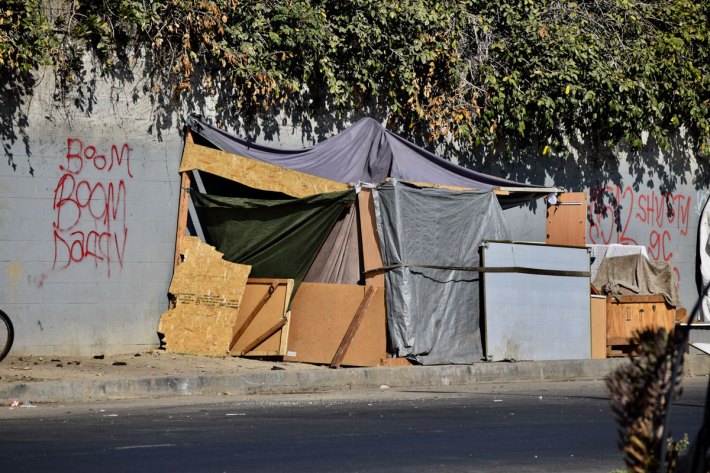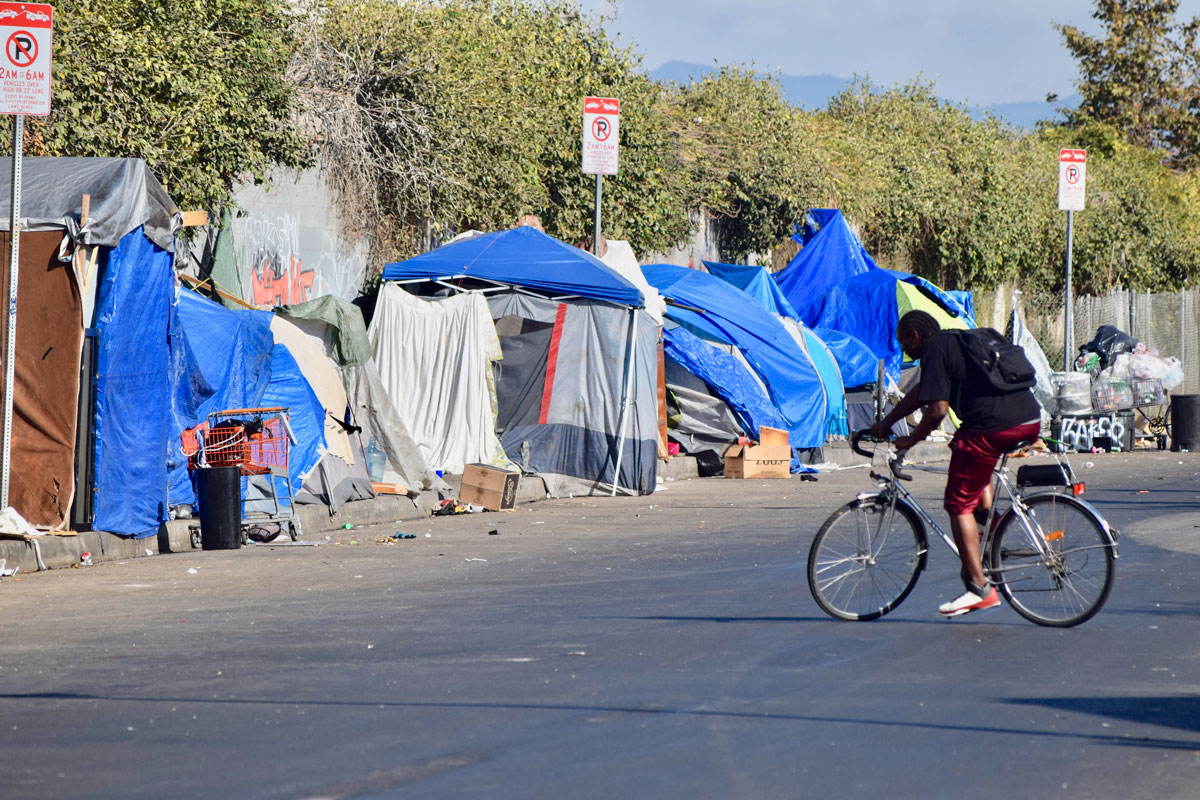[dropcap size=big]A[/dropcap] few years ago, Tobi Ford had to deal with the widely publicized death of her son Ezell at the hands of LAPD. Now, she is forced to live with people living in tents and RVs parked along the freeway outside her house in South Central Los Angeles.
The RVs have loud generators that run all night and Ford’s kids get up early for school. For two months her water bill was $800. She later found out that people were filling up jugs from her water hose when she left for work.
Homeless encampments are becoming more prevalent on the east side of South Central’s residential neighborhoods, highlighting a growing trend as the city’s homelessness crisis seems to only grow worse. Places with less community oversight are beginning to see large “tent cities” popping up in their neighborhoods, especially in areas south of downtown.
'Is this what they have to look forward to in life?'
Makeshift housing structures made of tents draped with tarps are lined up for blocks along the 110 Freeway on south Flower Street and Grand Avenue. Multiple broken down RVs are parked along the curbs. Trash piles on streets and corners, no matter how frequently the city schedules trash and bulky item pickups, neighbors say.
“I know the mayor has kids and he would not be happy for his kids to see this. It’s depressing,” Ford, a longtime South Central resident, told L.A. Taco. “I don’t know who these people are in these tents. I worry when I see kids walking. I hate it.”
RELATED: ‘They Thought a No Vote Was For Rent Control’ ~ What Happened to Prop 10?


Although she says she has compassion for the homeless, Ford worries about the safety of her daughters and the messages these sights send them. “What kind of hope of a future is this giving to our kids? Is this what they have to look forward to in life? To grow up and live like this?”
Ford says she called her elected representatives but was told the homeless have rights. Her district's City Council representative Curren Price did not return a media request for comment. Activists and homeless advocates told L.A. Taco that the spread of homeless encampments into the city's residential neighborhoods was inevitable given the current crisis.
“I think what we are seeing is more people using tents, and that’s more visible than homelessness used to be. They are not behind dumpsters and down the alley. They are more public,” Herbert Smith said.
Smith is the current director of the Los Angeles Mission, located on Skid Row, which is one of the largest service providers to the homeless in L.A. County. He noted these changes were due to lawsuits against the city by the ACLU and not enough services for the growing homeless population.
RELATED: L.A. County Serves Eviction to American Legion Where Homeless Housing Project is Slated

[dropcap size=big]I[/dropcap]n 2006, the city of Los Angeles signed the Jones agreement, which allowed people the right to sleep on streets from 9 p.m to 6 a.m. The decision was part of a settlement reached in Jones v. Los Angeles, where a judge ruled that L.A.'s law at the time against sleeping on the streets was unconstitutional.
Downtown Los Angeles is a little over five miles north of South Central and Skid Row holds the largest concentration of homeless encampments in the country. New developments and investments are quickly springing up in the downtown area. These appear to be pushing the homeless population into the heart of South Central, advocates say.
At a Skid Row town hall meeting earlier this month, Los Angeles director of Mental Health Jonathan Sherin said it is relatively clear homeless numbers are rising. “It’s hard to keep up. I believe we are providing more services and housing but we are not gaining ground at a commensurate rate,” Sherin said.
He also noted people are falling into homelessness by things that are societal in nature. “We are a divided community and society. And we are in a place where it’s hard especially – in L.A – to get a job that is going to pay enough money. It’s hard to get a full education. There are a confluence of issues that are driving people into homelessness.”
RELATED: Study: Business Improvement Districts Use Your Tax Dollars to Harass Homeless People

General Jeff told L.A. Taco he believes that homelessness will not end anytime soon. Jeff is a Skid Row community activist who says he reduced himself to a state of homelessness to better understand the issues. He said the focus is not on addressing the root causes of homelessness, but to maintain what he refers to as the “homeless industrial complex.”
“If all the non-profits on Skid Row are getting combined income in the hundreds of millions of dollars, why does it seem to be a lack of resources? It’s a money game to keep white America working while black America suffers greatly.”
Los Angeles was recently awarded $85 million to provide housing and resources to the homeless, and received a full disbursement from the state through the Homeless Emergency Assistance Program. Another $81 million was awarded to the Los Angeles Homeless Service Authority. Even still, people are living on the streets of South Central in complete squalor, with the sad reality that many Angelenos are just a bad month away from the possibility themselves.
Fanny, 24, lives in a homeless encampment in South Central along the freeway. She grew up in the area and said she ended up on the streets by trying to help the wrong people.
“You will end up in a bad situation by saying two words to the wrong person all because someone needed a come up and they came up on you. You will really be left with nothing and have to start over,” she told L.A. Taco. “Don’t settle for living in a tent.”
RELATED:
Photos by Tina Sampay.
RELATED: Skid Row Cleanup Threatens Seizure of Homeless Property Amid Typhus Outbreak







